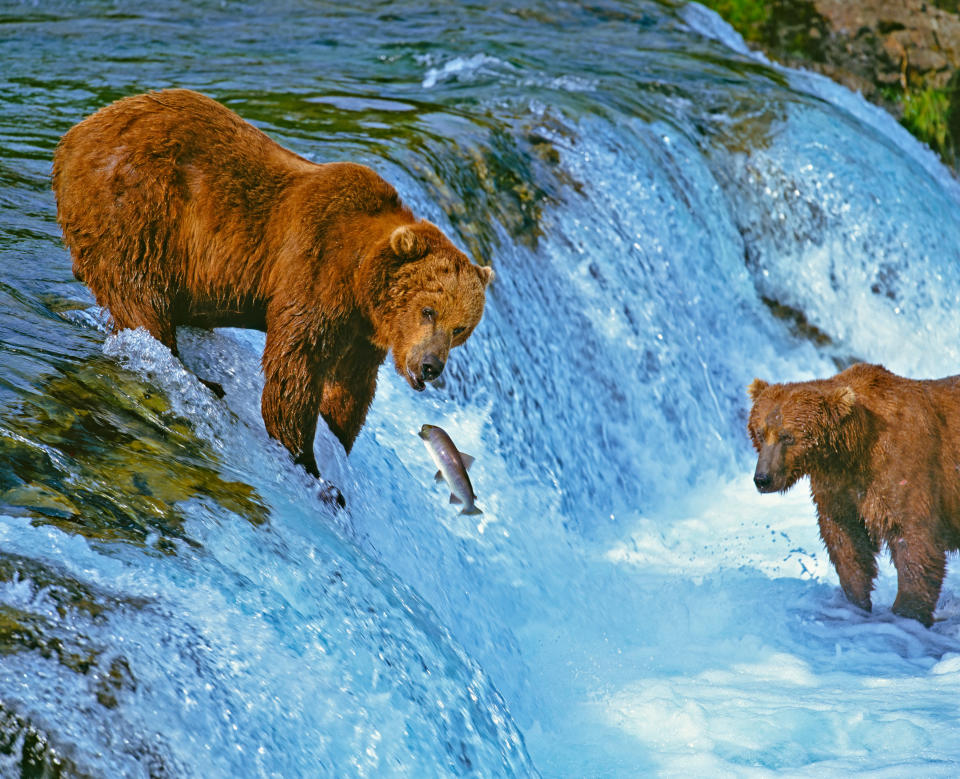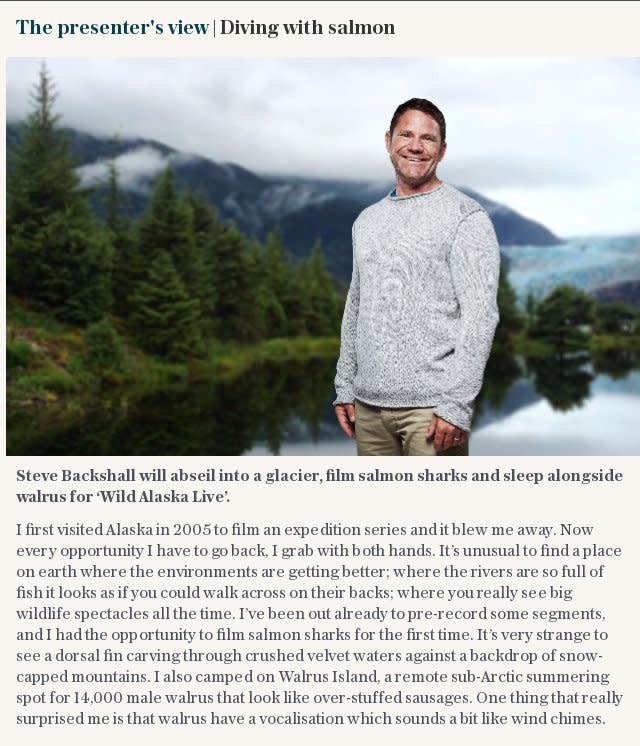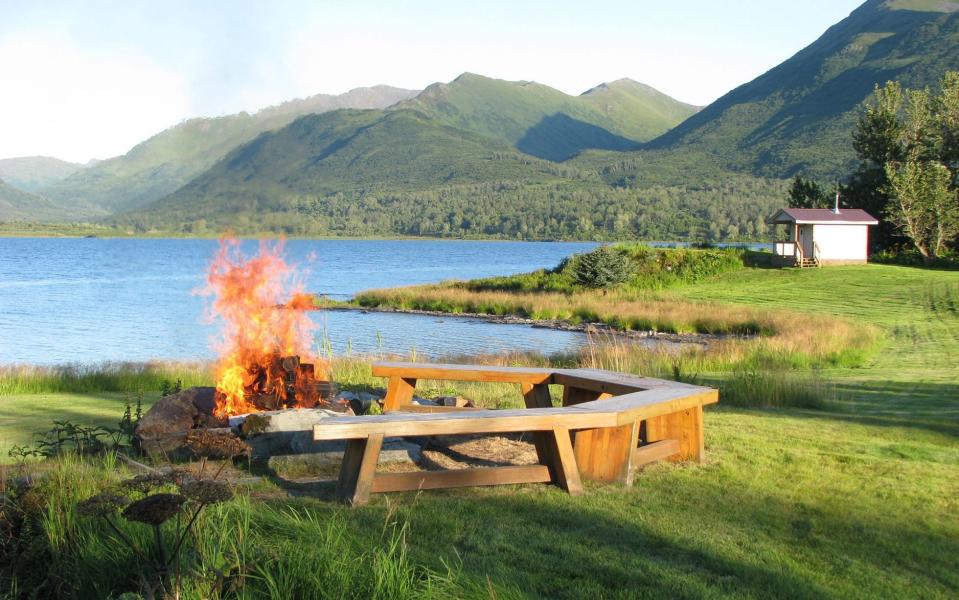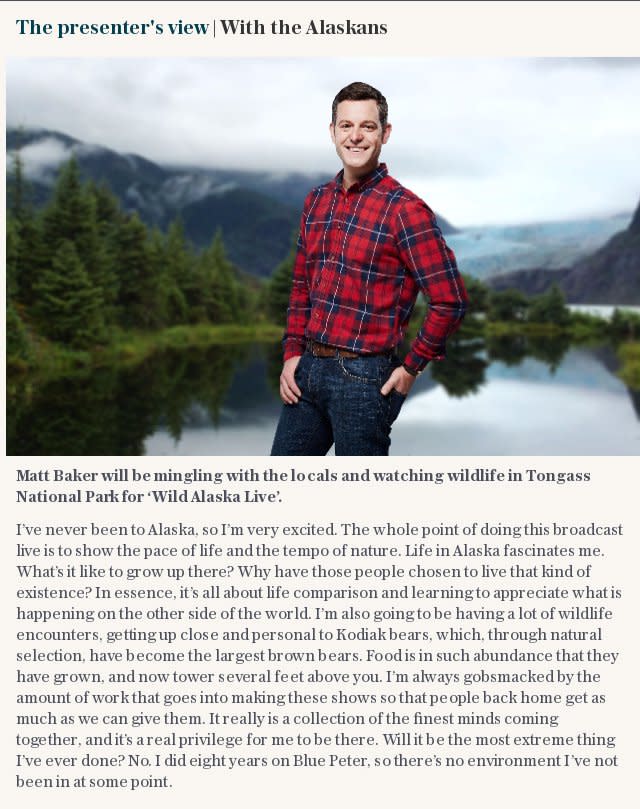Why this remote Alaskan island is the world's wildest destination

“Richard, there’s a bear outside your window,” roars a voice, waking me up. I’m on Kodiak Island, Alaska – one of the most remote places on the planet – to write about brown bears in anticipation of the BBC’s major three-part event, Wild Alaska Live, so I suppose it’s good news... but right outside my window?
You see, Kodiak bears are not your typical Ursus arctos (brown bear). They are in fact the larger cousin of the grizzly, and so improbably huge that in photographs (usually right next to grinning hunters), they look as if they’ve been Photoshopped; indeed, some mature boars (as the males are known) have been known to stand 11ft tall and weigh up to 1,500lb. Would you want one knocking on your door?
Starting on Sunday evening, BBC presenters Matt Baker, Liz Bonnin and Steve Backshall will cover one of wildlife’s greatest spectacles, the annual salmon run, live – and their thoughts and hopes are highlighted on the pages that follow.

The salmon run marks a crucial time in nature’s calendar as it triggers a summer feast for black, brown and Kodiak bears, as well as Alaska’s other magnificent animals, among them walrus, wolf, beaver, moose, bald eagle, orca and humpback whale. Karluk Lake has the highest density of fish in the entire Kodiak Archipelago, drawing red salmon in June, pink in July and silver in August. And where in Alaska you find salmon, you find bears.
There is nowhere better from which to witness their arrival than the Kodiak Brown Bear Centre (KBBC) located to the north-east of Karluk Lake. To reach it I take a 40-minute helicopter ride from pretty Kodiak City. With its colourful crab nets and cheery nautical types, it’s a composite of every fishing village you have ever wished you lived in. As we fly across Kodiak’s lush quilt of bottle-green meadows and mountains, rugged beaches and dark bays stitched with turquoise, I’m keeping an eye out for resident orcas and fin whales. Instead I see hundreds of sea otters on their backs, as if sunbathing.
Keller, my pilot, skilfully manoeuvres us through pockets of turbulence and mist and we alight upon a wooden jetty to pick up my bear guide: former park ranger Jennifer Culbertson.
“Just like people, not all bears are predictable,” she tells me. “Are Kodiak bears really bigger than grizzlies?” I ask. “Sure, they’re longer-legged with bigger bone structures.”

Then she gives me a little history lesson: 12,000 years ago the ice connecting the archipelago to mainland Alaska melted and the bears became isolated. Thanks to an abundance of food, they grew and grew. As we crest the top of a mountain, Keller points out a huge bear thundering away from us like a fur-clad freight train. I’m spellbound by his swiftness. Apparently they can reach up to 40mph – about the speed of a horse – so there’s no outrunning a Kodiak bear.
The fog parts and we descend upon 12-mile-long Karluk Lake, closing in on a small island with a manicured lawn, half a dozen attractive cabins, a cookhouse and a jetty. The surrounding landscape could be the love child of Pembrokeshire and the Scottish Highlands. A rangy figure with gimlet-blue eyes appears by the landing zone and introduces himself as Ed Ward, general manager of the KBBC. As he steers me to the cookhouse, a fox appears and follows us like a dog. I hear a crowing and Ed points to a nest 20ft up a nearby tree. In it are a pair of bald eagles and their young. I feel as if I’ve wandered into an illustrated encyclopedia.
“You haven’t seen anything yet,” he says, laughing. “Never mind humans coming to watch the animals… it’s the other way round, here.”

My cabin is luxurious, with a balcony looking out on the lake and mountains; a slate-floored, rain-shower bathroom with piping hot water; warm wood floors; and a huge bed. The lodge’s electricity is sourced from two soundless horizontal wind turbines. But for food, the place is entirely sustainable. “If there happens to be a zombie apocalypse, this is just about the best place to be,” says Ed.
Natasha, KBBC’s instantly lovable chef, sets me up for the day with a fine brunch of vegetable soup and home-made bread, then Jennifer and I board the centre’s catamaran and putter silently up the lake to the mouth of Thumb River. I’m tingling with excitement. Wearing nets over our faces to keep out summer midges, we squelch through chest-high grass and ferns, Jen regularly calling, “Hey bear,” just loud enough for a hidden colossus to hear us.

I almost step in wet black bear scat. “It’s still fresh,” says Jen, “maybe passed a few minutes ago.” Despite the shotgun slung over her shoulder, my heart is thumping and I’m thinking about poor Timothy Treadwell and his famous, fatal encounter with a bear in 2003.
Jen is also an artist and, curiously, the most popular of her prints is the red-eyed boar that ate Treadwell and his girlfriend. A moment later she whispers “Up there,” pointing to a Caramac-blonde bear with a face like Paddington. “He’s still a baby.”
Draped over the bough of a cottonwood tree 50ft away, he couldn’t be more adorable. Then she spots a swatch of amber moving silently in the shadows. “It’s the mothers you have to watch out for, they are very protective. Let’s keep moving…”

Ten minutes upriver we take a rest, planting ourselves on a bluff, listening to the deafening silence hanging between the lake and the mountains. The surrounding hills, I notice, are threaded with what looks like nature’s answer to town planning. “They’re bear trails,” says Jen.
Suddenly I remember I’m in one of the most remote places on the planet, trespassing on the territory of one of the largest carnivores known to humankind. Fortunately, they’re not exclusively meat-eaters; 80 per cent of their nutrition consists of roots, berries, grass and plants… the rest is meat and fish. “Human meat?” “Nah, we’re not on the menu.”

But that’s not to say the bears are unaware of us; mature boars have become nocturnal because of the constant threat posed by hunting – statistics show that 91 per cent of males end their life with a bullet in them. There are approximately 3,500 Kodiak brown bears across the archipelago, and each year 5,000 hunters spend $450 (£345) each to enter a lottery to win one of 496 permits granting permission to hunt a boar. If successful, it costs an additional $20,000-$30,000 to go out with an experienced guide. The money raised is ploughed straight back into the local economy, while the bear population is kept in check.
Shortly, a lone female shuffles along the opposite bank towards us. She can smell us downwind and through my binoculars I see her beady eyes fix us, then, unperturbed, she grazes on the pasture. It seems to me that shooting such a static target that has no designs upon you would be a rather Pyrrhic victory.

Back in the boat we spot another bear on the shoreline; a sub-adult male with a russet hide and regal head disproportionately large for his lanky legs and body. He’ll reach maturity and a fuller girth at around 10, whereupon he’ll begin his fighting years with other boars for the right to mate. Jen tells of a tagged bear which caught the scent of a female in heat and climbed over a mountain to reach her on the other side.
As a bald eagle (common as crows here) swoops over the boat, yet another bear pops up out of the foliage by the shoreline, following a fox being dive-bombed by a pair of magpies. Being so close to these natural dramas and going almost unnoticed is a real privilege. And while you may see more grizzlies gathering by the waterfalls at Katmai National Park (on the mainland), you won’t experience the sense of natural immersion that comes with a stay at the KBBC, for at any one time only six people are allowed to stay here. In another few weeks the river mouths will be teeming with fish and stacked with hungry bears, but for now the salmon – the size and colour of traffic cones – are just assembling.
The next day Jen and I sail south down the lake, to the mouth of the O’Malley river, where you can see stone weirs created hundreds of years ago by the native Alutiiq people to catch salmon. Instantly we sight a golden-brown female lying down on her back just over the river. She looks like she’s fallen asleep, so we carry on walking, only to return 15 minutes later to spot a huge boar, which on seeing us disappears rapidly into the brush. Patience is definitely a virtue when it comes to watching bears.

On my last morning I meet the bear outside my window; a young female, named Betsy, which regularly swims across the lake to visit. Beside her is Mr Kabignuk, the resident fox, her favourite playmate. Meanwhile, by the dock some otters are playing; behind them, a beaver is taking his morning dip; and one of the bald eagles has just passed over me with a shadow the size of a hang-glider. It’s like waking in Eden.
Ed appears with a cigarette between his teeth. “You meet the locals yet?” Right on cue three Sitka deer appear from the tree-line and amble toward us. “How did the animals get so trusting?” I ask.
“If we’re consistent in our behaviour and make a minimal impact on them, they begin to associate us with their environment,” he explains. “Female bears feel so comfortable at the centre, they bring their cubs here to play.”
As I tuck into my last breakfast there, the lake popping with red salmon, I hear the sound of rotors and Keller’s helicopter appears in the denim sky to spirit me away to my world.
My heart sinks at the prospect.
The essentials
Richard Waters travelled with Steppes Travel (01285 601050; steppestravel.com), which offers an eight-day itinerary to Alaska, staying four nights at Kodiak Brown Bear Centre and one night in Anchorage either side, from £6,495 per person on a twin-share basis. It includes international and internal flights, all transfers (float plane to Kodiak) and accommodation on an all-inclusive basis with meals and daily bear viewing.


